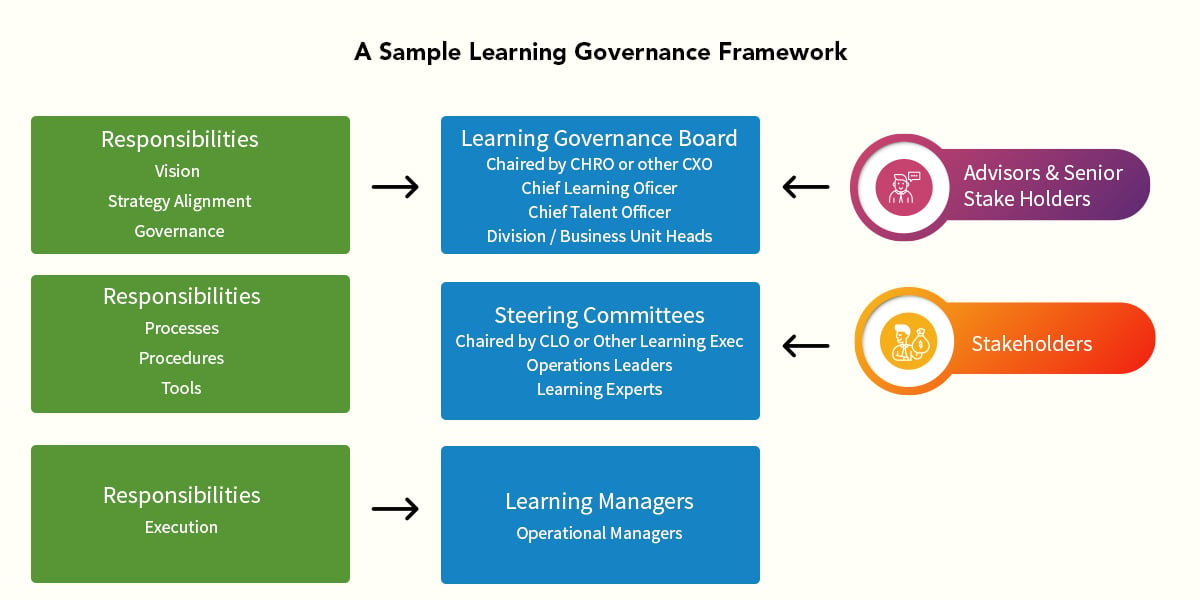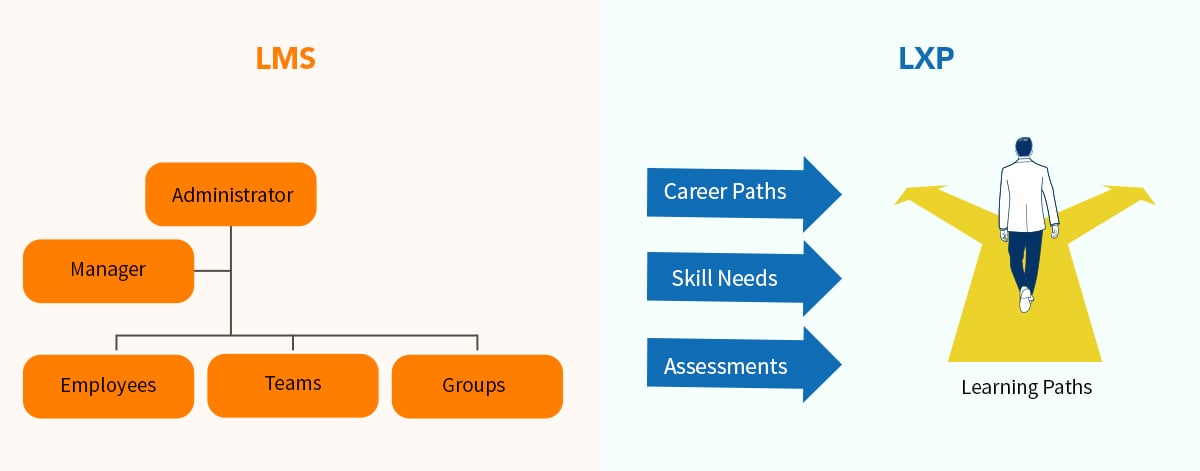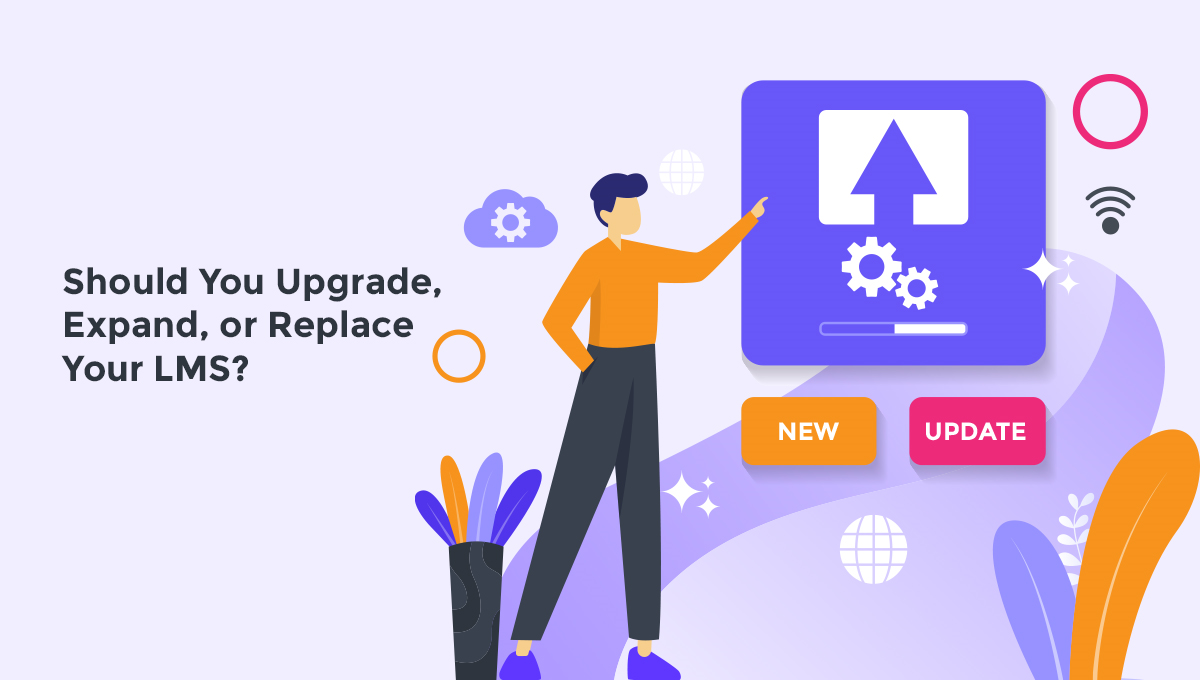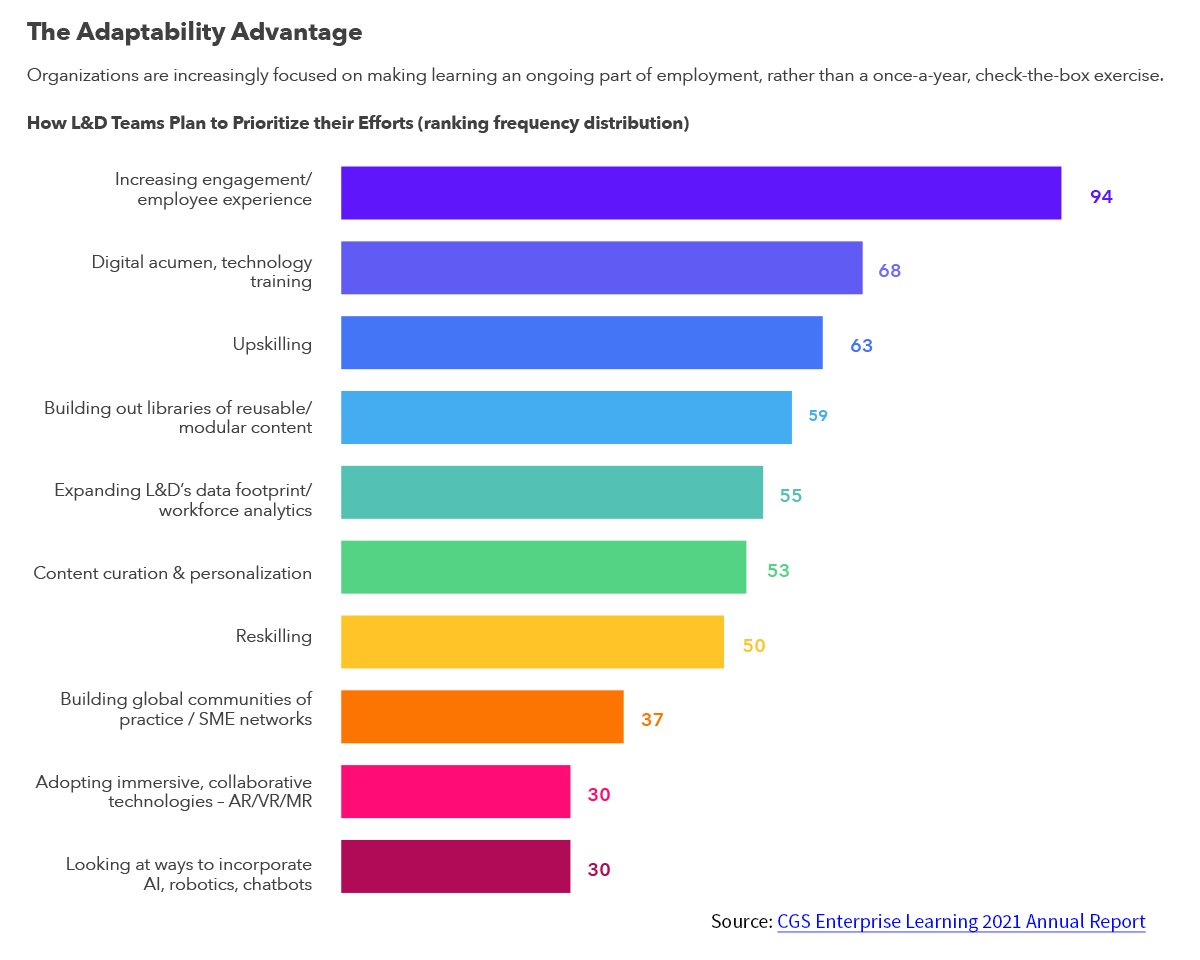Introduction
With the changing role of L&D and rapid advances in technology, you now have a dizzying array of choices if you need to upgrade, expand, or replace your LMS.
What you do depends on your business strategy, workforce strategy, and learning strategies.
A simple approach presents three general options, but you may find yourself doing all three:
Upgrade the LMS?
If you have an on-premises solution that you haven’t upgraded, consider moving to a cloud solution with the same or another vendor.
Cloud Software-as-a-Service (SaaS) gives you flexibility, reliability, and easy connectivity you don’t have with an on-premises perpetual license.
Expand the LMS?
You can integrate easily with LXPs, online providers, and the learning marketplace to create a learning ecosystem that serves the unique needs of every part of your enterprise (Figure 1).
Replace the LMS?
If your LMS is holding your people back, it may be time for a change. And, unless you have needs that an LMS specifically serves, you may not need one at all.
The LMS decision is not simple or easy. Still, if you understand the alternatives, you can find a solution that will fit your needs.
The Changing Role of L&D
Things have changed in the three years since we last explored LMS decisions. The most stunning changes are in the role and perception of the Learning and Development function.
Let’s review some of the findings in LinkedIn’s 2021 Workplace Learning Report:
- 66% of L&D pros agree they are focused on rebuilding or reshaping their organizations this year.
- 64% of those pros agree that L&D has shifted from a “nice to have” to a “need to have” in 2021.
- 87% of executives notice or expect skills gaps in the next few years, yet less than half know precisely how to address this issue. They are turning to L&D to lead the way.
- In 2020, L&D’s focus was adapting to the requirement for remote learning. In 2021, it is upskilling and reskilling.
- Business leaders are concerned about having the right leaders to navigate today’s challenges, so L&D is responding.
The 2020 pandemic taught us that events and external forces could change strategic priorities overnight. L&D invested in digitization and a shift to remote work and virtual learning.
In 2021, organizations needed their learning teams to build a resilient and flexible workforce.
Rather than training for defined work processes that could change overnight, the future watchwords will be proficiency, engagement, innovation, and a connection to the organization’s purpose. A workforce engaged and committed to the company’s purpose will adapt better and faster to changes.
L&D’s principal focus is now on employee experience and engagement to foster the proper learning.
The CGS Enterprise Learning 2021 Annual Report gives us a breakdown of where learning organizations will spend their energy this year and beyond (Figure 2).
The Changing Learning Technology Landscape
There have been equally dynamic changes in the technology we use to facilitate learning.
The LMS was invented to deliver, track, and certify required training in regulated industries.
The primary uses of the LMS in the 2000s were to:
- track compliance training to reduce regulatory risk,
- manage quality and consistency of learning across the organization and alert managers to deficiencies,
- deliver learning to partners to support distribution and sales channels, and
- create revenue streams by offering training to partners, customers, or the public at large.
Those needs still exist, but times have changed.
Hundreds of vendors sprang up to provide learning opportunities to employees, students, and the public.
Universities delivered course lectures online in free Massive Open Online Courses (MOOCs).
The online Learning Marketplace was born. For a small subscription or per-course fee, we could learn anything, anywhere, from hundreds of online providers. Even corporate universities went online.
Today, intuitive interfaces have replaced the clunky platforms of a few years ago. The focus is on the learner experience.
A phenomenon called the learning experience platform (LXP) arose to fill the gap between the structured, top-down LMS experience and how people want to learn.
These platforms provide a self-direct experience, they can pursue any learning goal at their own pace and in their way.
How Governance Can Help You Get the Right Technology Mix
The modern enterprise isn’t likely to have a single workplace learning solution. Rather, the enterprise must deliver a learning ecosystem with the flexibility to support rapid change.
Getting the right mix takes an enterprise-wide view. A learning governance framework will create the foundation for collaboration and help your enterprise allocate learning resources across the organization.
Rather than competing for resources, governance enables your people to work together to meet the needs of every part of the organization. It includes all the stakeholders in enterprise learning (Figure 3), so each group has a voice, and it standardizes decision processes (not decisions) to enable faster decision-making.
Figure 3

Now that we’ve laid the groundwork, let’s look at some specific cases that can alert you to the need to do something about your LMS.
Symptoms of a Broken LMS and What to Do About It
A robust learning management system is a valuable tool.
Not only can it help you manage and deliver training, but it can also make your workforce more engaged and productive.
If you find you’ve outgrown your old, outdated LMS, it might be time to update your learning technology.
As we saw in our Introduction, the learning ecosystem has undergone seismic shifts in enabling people to grow their knowledge and skills to improve business results.
If your LMS isn’t performing, you may need to replace it. Here are five symptoms your LMS needs modernization:
1. You can’t upgrade
If your business has grown and your LMS can’t keep up, you may find you need to upgrade to remain competitive.
You may have grown from a single location to many, or you may plan to globalize your business.
You may find that upgrading is an expensive proposition fraught with risk.
2. Your people don’t use it.
Ours is now a connected world. People have become accustomed to simple, easy-to-use applications at home and on their portable devices.
If using your LMS is a step back in time, upgrade.
3. It can’t use modern learning methods
People learn best in short bursts, with the knowledge tied to a specific challenge or need.
The on-demand video has become the most popular delivery method, and gamification is very effective. The top-down “we’ll tell you what to learn and how to do it” won’t work anymore.
4. It’s not connected
The internet has become a vast learning library. Over a billion people use it to gain information on topics from baking cookies to quantum mechanics.
Companies are tapping this extensive resource, curating web content instead of creating it, and saving time and money.
5. It’s not helping your leaders run the business
Executives need to know what the state of the workforce is now, what it needs to be in the future, and how they can upskill to be competitive.
If your LMS isn’t delivering actionable business intelligence, it is time for a change.
New technology helps evaluate the impact of learning on people and profits. If your current LMS isn’t helping you show ROI on learning and assessing the business impact, think about improving it.
6. It’s not extensible.
Companies that extend learning to their customers are more competitive and profitable. Consumer information and user training have become an integral part of the customer experience. Customers with a positive customer experience spend more.
Extending learning to partners, resellers, franchisees, and distribution channels gives you a competitive advantage. Well-informed partners sell more and serve their customers better.
To help with your decision, read our article on extended enterprise learning: Empower Your Supply Chain With SumTotal Extended Enterprise Learning.
The Vital Roles of an LMS and an LXP
Every time the Learning industry transforms, it reinvents the way we conduct learning.
When e-learning arose in the 90s, businesses almost shut down their physical universities.
When the LMS integrated with talent management systems in the 2000s, we changed how we develop talent.
But the demands have changed now. Twenty-first-century workers aren’t hard workers—they are smart workers.
The learning technology market has undergone a massive shift. At the center of that change is the learning experience platform (LXP).
At first, an LXP may seem like a traditional LMS because it delivers learning on-demand to its audience—but fundamental differences existed between them.
Differences Between an LMS and an LXP
An LMS is designed for administration, learning content delivery, and tracking and reporting learner development.
On the other hand, an LXP is a personalized learning platform.
It enables you to curate and aggregate content, create learning pathways and career paths, and enable your workforce with continuous learning in work.
Admin-driven vs. Employee-driven
n LMS is top-down, pushing training to employees. Administrators control what they see.
An LXP is user-centric. Employees decide for themselves what they learn.

Closed vs. Open Platform
In the past 20 years, e-learning modalities have evolved into blended, social, and micro-learning, using gamification and virtual reality (VR) and augmented reality (AR) simulations. We deliver those in closed systems.
The LXP is an open platform with content sourced from the online learning marketplace. It provided a consumer-grade experience with ease-of-use that contrasted with the LMS experience of the time.
More importantly, it could also track and analyze learning activities outside the platform to provide a holistic and robust learning experience.
Course Catalogue vs. Recommendations
In an LMS course catalog, there can be thousands of courses to search through.
Administrators struggle with curating and indexing them based on their user-specific needs. The course library expands over time, creating a “problem of discovery.”
LXPs use various methods of curation mechanics such as skills, interests, or content usage trends.
We have additional metrics with AI to make content more tuned to the learner’s needs.
Compliance vs. Impact
Complying with regulatory requirements is vital for every enterprise.
The LMS focused on these essential areas and provided the tools for the organization to drive compliance.
Employees perceived learning as a chore rather than an opportunity to learn and grow.
LXP's play a vital role in driving learner engagement and creating a learning culture in the enterprise. They can affect your workplace culture and influence the growth of your business.
When employees embrace the continuous learning culture and bring learning into their workflow, it drives value. It plays a vital role in their growth.
How the LXP Drives Change
L&D has been undergoing a seismic change driven by the need for a learner-centered experience.
Today’s employees and learners are career-oriented and expect their employers to support their development. If they don’t get growth, they move on to a company that will.
A recent Dell Technologies study indicated that “85% of the jobs that will exist in 2030 haven’t been invented yet.” Many industries have called it the moment of opportunity for L&D.
Learning teams need to deliver learning on-demand to support workforce development.
21st-century employees prioritize their learning opportunities now more than ever. But the average time an employee gets to spend on their personal development is 24 minutes a week.
So, there has been a demand for bringing learning in the flow of work, where people can access knowledge where and when they need it.
The LMS has long been a competent tool for learning. But with the rise of the internet, there was also a demand for more open and readily available sources.
And those sources needed more flexible and robust platforms.
The LXP-LMS Collision
Instead of designing the experience to fit the standard, the LXP enables companies to define the underlying data model.
For several years, LXP vendors compared their products to the clunky LMS, but times have changed.
- LMS Vendors have modernized their user interfaces to provide a smooth, user-centric experience. Mobile delivery, interactive video, and micro-learning are standard features.
- The modern LMS integrates with the LXP, the LRS, the learning market, social learning tools, analytics, mobile learning, and other business platforms.
- Many LMS vendors now have human capital management platforms that perform an array of employee experience services.
- LXP's have discovered that they need to provide the tracking and mandatory certifications required by regulated industries, becoming more like the LMS.
Do you need an LMS, an LXP, or both?
There is no straightforward answer to the LMS/LXP choice. Each is becoming more like the other, but they still differ in their fundamental approach.
We’ll pose a few questions to help you along.
Do you have mandatory compliance reporting requirements? Nothing does that better than an LMS.- Do your people need to earn certifications to advance their careers? The LMS does that well.

- Is your learning participation rate lower than you want it to be? Perhaps you need a more user-friendly solution.
- What skills do your people need to adapt to the changing business environment? What is the best way to gain them?
- Does your learning solution need to support customers or your distribution channel? An LMS can handle it, or you can get a system built for the purpose.
- Would it serve you best to use an LMS for centralized requirements and a distributed model where business units manage their learning needs?
If you need a deeper dive, contact us for a free consultation to evaluate your strategy. Click here to make an appointment with Sean Teague, our Business Consultant.
Building the Business Case for Replacing Your LMS
When you ask us about building the business case to replace your LMS, you might not expect our first question:
Who wants to replace it and why?
Who matters because the right decision-makers must support the initiative. Why is essential because business results matter.
With those factors in mind, let’s walk through the steps in building your business case.
1. Identify the Decision-Makers
The first step in getting approval is to learn how proposals and projects get approved in your organization. Seek people who have had their projects approved and how they went about it.
Study the factors that drive decisions in the business and who makes them. Find out what keeps your decision-makers awake at night, so you know their concerns in advance.
- Does your company regard L&D only as a cost center? If so, it is not likely that spending more on a new learning platform will excite your CFO.
- Do line-of-business leaders know what value learning will add to their bottom line? If not, you will see no cheerleaders there.
- Will you be competing for budget against revenue operations? If they don’t see a direct connection to income, you won’t get much enthusiasm.
Read on to see how those people will give you their support, even if they don’t yet realize it.
2. Form Alliances
In your organization, you have people who understand how learning can drive business results. Get them on your team by becoming their ally. Help them solve their problems with learning.
We recommend you start with:
- Finance: Learn the language of Finance and engage them in identifying the return on learning investment.
- Marketing: This part of the business has been measuring human behavior for decades. They understand how people impact revenue. Not to mention that they have unique learning needs.
- Line-of-Business Leaders: You will want the support of the people who are responsible for business results. Show them how your learning programs can impact their performance results, then engage them in discussions about how to improve those results.
Read the blog
The Ultimate Checklist for Selecting the Right LMS
3. Define Your Business Needs
Your allies will be your source for business needs. Frame your discussions in the context of solving their problems.
4. Evaluate Options
Work with a trusted partner. You may want to work with an independent provider like Pixentia who can help you evaluate vendors. Choose one who is not biased toward any particular solution. Evaluate solutions on how well they fit your needs, not how you can adapt to the solution.
Your partner will have the tools you need, such as a Request for Proposal and a comparison worksheet.
5. Calculate the Costs
If you are unfamiliar with cost analysis, your Finance team can guide you.
Break your costs down into project costs, licensing costs, and maintenance costs. Keep in mind that a software-as-a-service solution (SaaS) will include maintenance and updates in the licensing costs.
6. Calculate the Benefits
If you are moving to the cloud from on-premises, your IT costs will be much lower, as all customers of a cloud vendor share the hosting costs.
Root out all the costs savings and add them to your calculations.
The impact of learning on the business isn't intangible. It can have a huge actual impact on revenue, costs, and risk exposure. Work with your risk managers to estimate the saving in risk mitigation, and with your line-of-business leaders, estimate the impact of your solutions on revenue.
7. Calculate Return on Investment
If your finance team doesn’t have the tools, use an ROI worksheet to calculate the return on investment. You will also want to show the break-even point and the payback period. See in our example how the cumulative ROI becomes positive in the fifth year.
The worst possible event in your project is the one you didn’t anticipate. Be diligent about uncovering risks and estimating their impact.
9. Present Your Case
Your organization’s business practices will define how you shape and deliver your business case. Large organizations are likely to have a very rigid, prescribed format. Smaller companies may define it loosely or not at all.
Business Case Format
If you don’t have a prescribed format, you can use the structure outlined here.
- Executive Summary: The executive summary may be the only thing decision-makers read. Tell a brief, compelling story of how you identified a business need and developed a solution. State the project cost and how long until the project pays for itself.
- Business Need: Describe the problems and opportunities and link them to the business strategy. Convey urgency with data.
- Solution: Describe the solution and why you chose it. List alternatives and why you did not choose them, including the impact of doing nothing.
- Project Plan: Show major milestones and deliverables. Identify team members, business functions, and external entities and the roles of each.
- Impact: Describe the impact on the company. Quantify benefits and link them to the strategic plan.
- Risks: Include your risk analysis and mitigation plan.
- Return on Investment: Show ROI and the payback period. Discuss the factors in ROI calculation and the rationale for estimates.
The new world of learning shows excellent promise in preparing people to meet the challenges of the future. We hope your organization can capitalize on this opportunity.
Our purpose in this article has been to show you that you can often meet your learning needs without requiring major changes in your technology. If you do need to make a change, you can do it in a way that helps your business leaders feel comfortable that they have made the right decision.
We hope you found this guide helpful in making your decision about learning technology.
Phenomecloud is a full-service technology company dedicated to helping clients solve business problems, improve the capability of their people, and achieve better results.










Leave a Comment